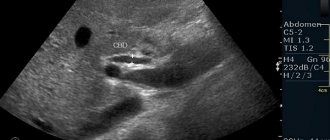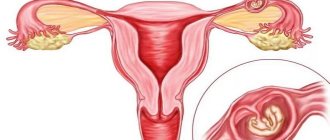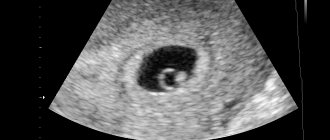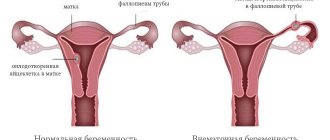You can't give birth. An ectopic pregnancy is a pathology that is life-threatening for a woman. It is intuitively clear that during an ectopic pregnancy, the fertilized egg is located not in the uterus, but in another organ. Most often (in 95% of cases) with an ectopic pregnancy, the fertilized egg is located in the fallopian tube. In more rare cases, the fertilized egg may be located in the cervix, ovary, liver, spleen, peritoneum, intestine, etc. Since none of the organs is suitable for bearing a child, it is impossible to maintain such an ectopic pregnancy, and, accordingly, to give birth.
As the fertilized egg develops, it begins to grow, rapidly increasing in size. This leads to severe distension of the organ, which became the receptacle for the fetus during an ectopic pregnancy. Since any organ other than the uterus is not adapted to such a strong stretch, eventually its wall becomes very thin and ruptures. Such a rupture of the wall of the abdominal organ leads to severe bleeding, which can lead to the death of the woman. Moreover, the further into pregnancy an organ rupture occurs, the stronger the bleeding will be, and the higher, accordingly, the likelihood of death for the woman.
Therefore, it is impossible to carry and give birth to a child during an ectopic pregnancy. As soon as a woman is diagnosed with an ectopic pregnancy, she should immediately undergo surgery, during which the fertilized egg will be removed and the organ that has become the fetal receptacle will be sutured.
Currently, there are several cases in the world where a woman gave birth during an ectopic pregnancy. One case was reported in Australia, where a woman carried the fetus in the liver for up to 20 weeks, after which she was operated on, the premature baby was removed and she was released. However, the reason for such a long course of hepatic pregnancy was its late detection, since the woman did not go to doctors to monitor her condition. Two more cases occurred in the United States. In one woman, pregnancy developed in the ovary until 36 weeks. It was during this period that the woman turned to doctors for help, because she feared that she would not be able to give birth on her own. US obstetricians successfully operated on her and extracted a living child. In the second case, the fertilized egg developed in the omentum. This unusual pregnancy was discovered quickly, but the woman asked the doctors to take a risk and try to save it. As a result, the woman spent all 40 weeks of pregnancy in the best hospitals in the USA under the supervision of leading obstetricians. However, she was able to bear a normal, healthy child, who was born by caesarean section.
It should be understood that all these cases are isolated, and the pregnancy was located in various organs of the abdominal cavity, and not in the fallopian tube. If the fertilized egg is localized in the fallopian tube, it is impossible to carry out a pregnancy, since the organ is very small and therefore ruptures by the growing embryo at 4–8 weeks of gestation. Therefore, if an ectopic pregnancy is detected, you should not try to save it, but immediately undergo surgery.
Is it possible to maintain a pregnancy?
An ectopic pregnancy is defined as the attachment of an already fertilized egg to organs in the pelvis.
If, with the normal location of the zygote, its attachment occurs in the body of the uterus, in its cavity, then with pathology, the fertilized egg is attached in the peritoneum, in the tubes.
In this case, the development and normal life support of the fetus, due to the fact that the organ is not adapted to bearing a fetus, is not carried out.
However, if pregnancy is long-awaited and desired, a woman has a reasonable question about the feasibility and possibility of bearing and giving birth to a child, even at the expense of her health. The safety of the fertilized egg in ectopic localization is not considered for several reasons:
- the organ to which the fertilized egg is attached (usually the fallopian tube) will not stretch as the fetus grows;
- the risk of death of mother and child (even with successful pregnancy) during childbirth is 80%;
- at any period of gestation, an organ rupture occurs, followed by intra-abdominal bleeding, which cannot be stopped;
- pathological localization is also dangerous for the baby, since it does not receive the necessary microelements for full development.
Even if we assume that it is possible to maintain an ectopic pregnancy until a safe term, there is always a risk of abnormal fetal development in such unnatural conditions. With an insufficient amount of oxygen, with hypoxia (oxygen starvation), abnormalities in the development of brain activity are recorded, and the child is born with cerebral palsy and mental development abnormalities.
Etiology of the problem of tubal pregnancy
This situation rarely comes to light. Several types of ectopic pregnancy are diagnosed:
- egg;
- abdominal;
- pipe
The last option is the most common. It is important to do the operation urgently; it will not be possible to save the child. Otherwise, you will have to save not only the fetus, but also the woman.
Cases are often diagnosed when uterine and tubal pregnancies are detected simultaneously. This happens if conception was carried out artificially, and doctors introduced several zygotes into the uterine cavity at once. They can migrate to the tube or ovary and remain there. One child can be saved.
The fetus sometimes moves from the uterus to another cavity after artificial stimulation of ovulation or treatment with medications to improve the functioning of the reproductive system. Sometimes a woman who has given birth can have an ectopic pregnancy if it is transmitted genetically. It is impossible to save such a child.
Pipe obstruction
Tubal pregnancy is diagnosed by ultrasound. But as the child develops, accompanying symptoms appear:
- nausea, vomiting;
- constant fatigue;
- bleeding, including after sexual intercourse;
- pain in the lower back, sacrum and abdomen.
During an ectopic pregnancy, it is impossible to give birth, since the fertilized egg bursts and can expose the expectant mother to enormous risks. Therefore, if symptoms appear, you need to make an appointment with a specialist. After the examination, it will become clear whether this is a pathology or not, and whether the fetus can be saved.
If one fetus is in the uterus, there is a chance that this baby can be born healthy. But it can only be preserved if an ectopic pregnancy is terminated. The earlier the problem is identified, the greater the likelihood of a positive outcome.
Is it possible to give birth
If we assume that the ectopic localization can be full-term, then the next question arises about the possibility of giving birth to such a baby. How safe and possible is it to carry out the birth process if the baby is not in the uterus?
Labor begins when, under the influence of a certain amount of hormones in the pregnant woman’s body, they accumulate and the uterus contracts, pushing the fetus out. What happens if the baby is not in the womb?
The uterus contracts, but such actions are ineffective, since squeezing out the fetus becomes an impossible task. The only option is a caesarean section before the onset of labor.
Is it possible to give birth if the pregnancy is in the fallopian tube?
Cases when attachment of the fertilized egg occurs in the fallopian tube are frequent. Literally 70% of all diagnosed cases outside the uterus are localized inside the tubes.
The safest place for a zygote is the place where the tube enters the uterine cavity, in the interstitial region. The formation and growth of the fertilized egg in a given place can develop for a relatively long period - up to 12 weeks. At 10-12 weeks, the baby’s heart is already actively working, arms and legs are visible, he looks like a little man.
However, the further growth of the baby provokes ruptures and deformations of the pipe, which can burst, the fetus itself dies, and the mother risks her life. Doctors do not allow giving birth if the fetus is located outside the body of the uterus. The joy of motherhood in such a situation can come at too high a price.
Cases of birth of children
And yet, have there been any cases in history when recorded ectopic development ended in the birth of a healthy child? It’s worth saying right away that most doctors today still question the examples below.
In London, in 1999, a unique operation was performed to remove a fetus that was developing in the uterine tube. The situation was complicated by the fact that the boy had two more sisters who grew up under normal conditions in the uterine cavity.
The pathology was recorded at the 18th week of gestation, but the doctors themselves questioned the possibility of carrying the pregnancy to term. However, the birth took place at the right time; during a caesarean section, first the sisters were removed, and then the brother, who formed a fetal place in the tube.
This situation is rare. As a rule, at a long time a decision is made to remove and move the fetus into an incubator, for example, the story of Jane Jones. At the 27th week, the woman learned that the baby was growing in the intestinal omentum. Doctors removed the baby from the intestines and placed him in an incubator.
The chance of survival was 2%, and the child took advantage of this. Today, an unusual child is growing up and making his parents happy.
During a long-awaited pregnancy, you want to hope for a positive outcome, but believing in a miracle is a risk to your life. There is no point in hoping that you will become a new case in history, putting your life in danger. Therefore, the right decision is to save the reproductive organs and prepare for a new case of fertilization
Source: formama.online
What is an ectopic pregnancy
With an ectopic or ectopic pregnancy, the fertilized egg is fixed with subsequent development not in the uterine cavity, but outside it.
The embryo finds a place in the abdominal cavity, on the ovary, on any internal organ, in the cervix.
The fertilized egg is an egg with protective membranes. Over time, it grows, the cells differentiate, becoming fetal organs and tissue structures.
But the fact is that the full development of the embryo occurs only in the uterus. As for fertilized eggs of ectopic localization, they die sooner or later.
When wondering whether it is possible to save an ectopic pregnancy, experts give the only answer - no. This fact is easy to explain. During development, the fetus needs:
- normal and stable blood circulation;
- the presence of an elastic and thick wall of the organ into which implantation is carried out and through which nutrition is subsequently provided;
- protection from external physical damage.
Similar conditions are provided by the uterus.
Treatment
The development of ectopic pathology is dangerous because identifying it at an early stage is quite problematic. Of course, there are many methods to diagnose fetal development outside the uterine cavity, but for this the woman needs to see a doctor.
Most women prefer to self-medicate, which causes unimaginable and sad consequences. Many ladies, feeling the first signs of pregnancy, run for a test, see a positive result and put off going to the gynecologist.
As a rule, ectopic pathology can be diagnosed only at 6-8 weeks, when pain in the lower abdomen becomes unbearable and blood discharge comes from the genitals, so the woman has to go to see a specialist. However, it is possible to save reproductive organs only if an ectopic pregnancy is detected early, otherwise doctors have to take extreme measures and save the woman’s life, and not her reproductive organs.
To extract the embryo, a modern technique is used - laparoscopy. Thanks to her, it is possible to maintain 95 percent of the patency of the fallopian tubes and give a woman a chance in the future to conceive and give birth to a full-fledged baby. In addition, the operation is gentle, so after a few days the woman can go about her usual activities.
Do people give birth with an ectopic pregnancy? Yes, such cases have been recorded in medicine, but they relate to miracles, not to real life. Every woman who wants to keep a child, contrary to common sense and the advice of specialists, must understand that her chances are practically reduced to zero, and at best, she will remain infertile, and at worst, she will leave this world.
Ectopic pregnancy occurs in 5-7% of cases, and it is detected in the early stages of pregnancy. It is characterized by the fact that the fertilized egg is attached not to the wall of the uterus, but to the fallopian tube. With further growth of the fetus, the fallopian tube expands and there is a high probability of its rupture, which will be accompanied by heavy bleeding.
Some women who face this problem are wondering whether it is possible to save an ectopic pregnancy. However, in most cases this is not possible.
The persistence of an ectopic pregnancy depends directly on what type of pregnancy is typical for the woman:
- Pipe
- Abdominal
- Ovarian
- Cervical
Regarding tubal pregnancy, special attention is paid to the fact that in case of an ectopic pregnancy it is possible to save the tube. This is what will allow a woman to have a higher chance of getting pregnant in the future.
Abdominal pregnancy is a fairly rare form of ectopic pregnancy. In this case, the fertilized egg can attach to:
- Spleen
- Liver
- Mesentery of the intestine
An abdominal pregnancy can be primary, when the egg immediately enters the cavity, or it may also be the case if the fallopian tube ruptures and the fertilized egg enters the abdominal cavity. This type of pregnancy can only be caused by complications with the fallopian tubes, where the egg could not implant. Characterized by severe nausea, bloating and frequent diarrhea. When asked whether an ectopic pregnancy can be preserved in this case, doctors answer that such a process is impossible and even dangerous for the woman.
Removal of the fertilized egg occurs using laparoscopy. They are quite rare and difficult to make.
Ovarian pregnancy is also quite rare. It is characterized by the fact that fertilization of the egg occurs even before it leaves the ovary. This can happen due to genetic disorders of the woman or colds during fertilization.
Cervical pregnancy is characterized by the attachment of the fertilized egg to the cervix. In this case, the pregnant woman must be hospitalized and undergo an operation to remove the egg. If the gynecologist is unable to remove the embryo due to various complications, then supravaginal amputation of the uterus may be used.
If the fertilized egg attaches to the fallopian tube, an ectopic pregnancy is diagnosed. In this case, you can save the pipe if you remove the fruit from it in time. Approximately 98% of cases of ectopic pregnancy indicate that the fertilized egg is attached to one of the fallopian tubes.
May occur if a woman has used hormonal contraception in the past. It may also be due to a hormonal imbalance in the body or in the case of a uterine tumor. If you do not contact specialists in time, the outcome may be a rupture of the fallopian tube.
Regarding the question of whether the tube is preserved during an ectopic pregnancy, it should be taken into account that in most cases it is possible to preserve it in the early stages. Even in cases where its removal is required, this does not at all indicate that the woman will not be able to become pregnant in the future. As a rule, the second fallopian tube does not have any abnormalities in its functioning.
If the fetus attaches to the wall of the tube and begins to develop there, then its removal is mandatory when diagnosing an ectopic pregnancy. Preservation of the tube is possible only if it has not ruptured due to the intensive growth of the fetus.
In order to prevent spontaneous tubal abortion with hemorrhage into the abdominal cavity from occurring, doctors are increasingly using a method such as laparoscopy for ectopic pregnancy with preservation of the tube. The procedure itself is quite painful, so it is performed under general anesthesia.
Is it possible to save an ectopic pregnancy?
If there is an ectopic pregnancy, can the baby be saved? Most women ask this very question, but doctors insist that this is impossible. In addition, if the fertilized egg is not removed in time, there is a high probability of blood poisoning and other complications. Therefore, intensive therapy may be required.
It is not possible to save an ectopic pregnancy, even if you take precautions and carry out constant therapy. Transplantation of the fertilized egg is also impossible, since there is not only a risk of disruption of the structure of the embryo, but also a high probability that it will not attach to the uterine cavity.
Treatment methods for ectopic pregnancy are effectively used, which are designed to preserve the reproductive organs as much as possible and not harm them in such quantities. Thanks to modern methods of removing a fertilized egg, it is possible to preserve a woman’s uterus and its appendages in a favorable condition for a successful pregnancy in the future.
To prevent future ectopic pregnancy, women are advised to completely get rid of any infectious diseases. If possible, you should consult with a specialist regarding the possibility of complications from chronic diseases, if any.
In most cases, gynecologists do not prescribe intensive therapy to prevent ectopic pregnancy. However, please note that if this occurs, you should not delay its treatment and removal of the fetus, as this may provoke infertility in the future.
After an ectopic pregnancy abortion, you should take a course of anti-inflammatory drugs that will improve the functioning of the body. They will also help protect a woman from the development of other infections in the body.
– this is a pathological condition, a complication when a fertilized egg (fertilized egg) does not enter the uterine cavity as expected, but attaches and develops outside it. An ectopic pregnancy is not viable because it does not have the conditions for development, and is dangerous for a woman due to rupture of the organ in the cavity of which it was formed, internal bleeding and the growth of chorionic villi (formation of the placenta) into the internal organs.
An ectopic pregnancy has the same symptoms and manifests itself in the same way as a normal pregnancy. Determining where the fertilized egg develops - in the uterus or outside it - is possible only through ultrasound.
Pathological causes
Ectopic pregnancy is a more complex condition, which experts are currently studying.
The main reasons noted are the following:
- A history of inflammation of the appendages (fallopian tubes) is the main cause of the pathology. Even after complete recovery, there is no guarantee that an ectopic pregnancy will be prevented. During the disease, fibrous ties and numerous adhesions appear inside the tubes, blocking the path of the egg into the uterine cavity until the destruction of the outer mucous membrane of the embryo begins for implantation.
- Inflammation of the fallopian tubes, which leads to the death of villi on the mucous membrane, loss of nerve endings, as a result of which their normal transport function is disrupted. The fertilized egg cannot move independently; it stops in the fallopian tube, which leads to the development of an abnormal pregnancy.
- Abnormal development of the reproductive organs (presence of additional internal tubes, holes in the lumens). Pathologies develop in utero due to the fault of the mother who has suffered sexually transmitted infections, radiation, taking illegal drugs, etc.
- Surgical interventions leave behind adhesions and scars in the area of the appendages. They interfere with the normal movement of the egg.
- Disturbances at the hormonal level cause disruption of the menstrual cycle. As a result, the muscles in the tubal uterine apparatus become immobilized.
- Long-term use of drugs containing hormones, which leads to premature development of the embryo and its accelerated reaction to implantation. As a result, the embryo is fixed in the tube.
- Surgery to remove the fallopian tube. If ovulation occurs after a preliminary surgical intervention, the egg needs to go through a difficult and long path to a healthy tube. In such a situation, the described pathology may develop.
Causes of abnormal location of the embryo
There are many provoking factors for ectopic pregnancy during IVF. The reasons are varied, including the following:
But sometimes, with overstimulation, the pipes can be injured, and the hairs begin to move in the opposite direction. It turns out that they “pull” the egg from the uterus.
- Congenital and acquired pathologies (adhesions) of the tubes.
- Inflammation in the uterus and appendages.
- Previous .
- Infantilism of the uterus.
- (internal and external).
- The peculiar structure of the uterus. For example, two-horned or with one horn, .
- Internal female contraceptives – . They can disrupt the process of embryo implantation.
- Stress and physical overload.
Failure to follow doctor's recommendations after embryo transfer increases the risk of developing an ectopic pregnancy during IVF. Immediately after the procedure, you need to remain in bed for several days, do not physically strain, and do not be nervous. If a woman moves a lot, lifts weights, plays sports and experiences constant stress, then the risk of an abnormal location of the ovum increases.
Types of ectopic pregnancy
A gynecological abnormality related to conception is characterized by the growth of the fertilized egg outside the uterus.
Depending on where the embryo is implanted, the following types of pregnancy are distinguished:
- cervical;
- pipe;
- ovarian;
- abdominal;
- rudimentary.
If we consider the ovarian development of the fetus, it can be capsule and follicular.
Abdominal pregnancy has secondary and primary development.
Rehabilitation as preparation for a new conception
After removal of the fertilized egg, the expectant mother must devote herself entirely to full recovery and restoration of the normal functioning of the reproductive system. The rehabilitation course, the same as after a regular abortion, includes:
- Antibiotic therapy. Prescribed for the prevention of infections and inflammatory processes in the pelvic area.
- Infusion therapy. Prescribed within a week immediately after embryo removal to restore water and electrolyte balance.
- Treatment with enzyme preparations against the formation of adhesions.
- Physiotherapy. Prescribed 7-10 days after surgery.
- Hydrotubation. Necessary for dissolving adhesions in the fallopian tubes. Frequency: every 3 months after surgery.
During the first year after an ectopic pregnancy, doctors recommend using oral contraceptives.
Characteristic symptoms
Pathology related to improper conception begins like a normal pregnancy.
The woman feels nausea and general weakness, there is no menstruation, the uterus increases in size, and the mammary glands swell.
In some cases, menstruation does not stop, but more scanty discharge is observed.
Characteristic symptoms are headaches and dizziness, nagging pain in the abdominal area.
An ectopic pregnancy does not show any specific symptoms. A woman can only find out about her during a spontaneous interruption. This process is accompanied by uterine bleeding and stabbing acute pain.
An urgent indication in this case is to call an ambulance.
What to do if detected
After conducting the necessary research and establishing a diagnosis of “ectopic pregnancy,” surgical removal of the embryo will be performed. Spontaneous interruption in this case, unlike other types of pathologies, does not occur.
Therefore, the most favorable result is its identification at an early stage. The fewer days have passed since pregnancy, the easier and simpler the operation, the more chances it will give the woman to become a mother.
Laparoscopy is considered the best option. This operation is performed without incisions - using punctures. Through them, the ectopically located fertilized egg is removed. After it there will be no scars, scars or adhesions left. After a certain time after recovery, a woman can become pregnant again.
What is the danger?
The onset of pathological conception poses a threat to a woman’s life.
An embryo that is implanted outside the uterus can, over time, cause rupture of the organ to which it is “attached.”
The uterus is elastic in nature and stretches as the fetus grows.
The pipes are not intended for these purposes; if they are broken, severe bleeding occurs.
In case of complications, surgical intervention is directly indicated, and the issue of preserving the tube during an ectopic pregnancy is decided by the specialists performing the operation.
In some cases, it is difficult to conceive again after a surgical procedure on the reproductive organs.
Conditions for ending a pregnancy with a miscarriage
Do not despair
Abnormal pregnancy has adverse consequences for the woman. The result of an ectopic pregnancy is:
- pipe rupture;
- miscarriage.
With an ectopic pregnancy, they do not give birth and the child cannot be saved. In the first case, the fallopian tubes cannot withstand the division and growth of the egg. In the second, the fetus migrates into the abdominal cavity. In both cases, internal bleeding begins, which can be fatal.
A miscarriage presents itself with unexpected, severe pain. With an ectopic pregnancy, it is felt on the side where the baby is located. The pain can be cramping, aching, dagger-like. With an ectopic miscarriage, spotting brown discharge appears. It is important not to confuse them with menstrual blood. They are not that strong.
Saving the fetus is impossible. Therefore, after symptoms of miscarriage appear, you should immediately contact a gynecologist. There is a risk that you will not be able to get pregnant again, as well as save the next child.
Preservation of pregnancy and childbirth: is it possible?
If the baby is carried abnormally, there is a high probability of adverse consequences in the form of serious damage to the fallopian tube and miscarriage.
Is it possible to give birth during an ectopic pregnancy? No.
Experts do not undertake to save the child in this case.
The rupture of the tube, migration of the fetus to the abdominal area ends in severe bleeding, which can be fatal.
During an abortion, a woman experiences severe aching, cramping, dagger-like pain.
Brown, spotting discharge appears, but not as strong as during menstruation.
In such a situation, the question of whether it is possible to bear a child is no longer relevant.
At the first symptoms indicating a miscarriage, a visit to a gynecologist is indicated.
Can an ectopic pregnancy end in miscarriage?
Can there be a miscarriage with an ectopic pregnancy? Yes, it can end in spontaneous abortion or rupture of the oviduct.
At the same time, they need to be differentiated from uterine miscarriage, adnexitis, inflammation of the appendix, neoplasm and ovarian torsion. It is difficult to distinguish between these pathologies, especially at an early stage.
Typically, a tubal miscarriage, when the embryo is expelled through the ampulla of the oviduct into the peritoneal cavity, is observed at 4 to 6 weeks, and a uterine miscarriage usually develops later.
With an ectopic miscarriage, pain in the lower abdomen appears unexpectedly; it is localized on one side, in the place where the pathological process is observed. They can be of different nature, be:
- aching;
- dagger;
- cramping.
If internal hemorrhages open, they can radiate into the rectum and posterior fornix of the uterus.
In addition to pain, you may experience:
- vertigo;
- loss of consciousness;
- nausea, vomiting;
- hypotension;
- pale skin;
- rapid weak pulse.
Bleeding during a tubal miscarriage is light, spotting, almost brown in color, and contains pieces of tissue or uterine mucosa. They may be similar to menstruation, but not as heavy.
If a woman develops a uterine miscarriage, the pain is cramping, increases gradually, and is localized in the lower abdomen or lower back. They are accompanied by intense scarlet bleeding, in which clots can be found.
Chances of giving birth with a second ectopic pregnancy
The described anomalous situation may be repeated.
In any case, it is unacceptable to save and give birth to a baby in such situations. Even if there is an uterine and ectopic pregnancy at the same time, the medical verdict is the same - abortion.
Upon completion of this procedure, it is necessary to be examined by an endocrinologist, because The cause of pathological conception may be hormonal imbalance.
To achieve a normal pregnancy after an unsuccessful trip, a woman undergoes an examination and takes appropriate tests for:
- inflammation;
- chlamydia;
- gonorrhea;
- sexual infections.
If necessary, a comprehensive therapeutic course is prescribed.
After an ectopic pregnancy, you need to rest more and beware of strong physical exertion, which will help you carry your baby normally in the future.
6 months after the abortion, for medical reasons and a thorough examination by a specialist, it is allowed to plan a pregnancy.
Source: kakrodit.ru
When can you plan to conceive again?
Even after undergoing an ectopic pregnancy, there is still a chance to conceive and give birth to a healthy baby. To what extent this is possible depends in each specific case on where the fertilized egg was located and how traumatic the operation to remove it was. However, it is worth understanding that even if all reproductive organs are preserved, a woman’s fertility is already declining. The next pregnancy under the IVF protocol should be approached even more carefully.
Before you start planning your next attempt at conception, you need to complete a full recovery course for your body. Pregnancy must not occur during at least the first six months. Moreover, any sexual intercourse is prohibited after the operation for a month. Next, as a rule, the doctor prescribes oral contraceptives, they help normalize hormonal levels.
After surgery, a woman must undergo therapy to prevent inflammation and avoid the appearance of adhesions, cysts, fibroids, and tumors. In addition, physiotherapy procedures are prescribed, such as: UHF, electrical stimulation, ultrasound and laser stimulation.
Only after complete recovery of the body, research and treatment can the couple begin the next attempt to conceive. Sometimes after an ectopic pregnancy, IVF is the only chance to become parents.
And here is more information about how to do IVF.
It is possible to save the patient and preserve the opportunity to give birth to a child in the future only if an abnormality in the location of the embryo is detected in a timely manner. Ectopic pregnancy is a very dangerous pathology. A woman should seek medical help at the first alarming symptoms. In this case, the life of the mother comes first. It is not possible to save the fetus.
Main signs and symptoms, how to identify an ectopic pregnancy in the early stages. Ectopic pregnancy is a terrible diagnosis that any woman can hear.
In vitro fertilization (IVF) solves most of these problems, and constantly. From it you will learn about methods of preserving fertility, planning pregnancy, the effectiveness of IVF and ICSI.
Why does an ectopic pregnancy develop? A normal pregnancy takes place in the uterus. . Artificial insemination (IVF, ICSI).










